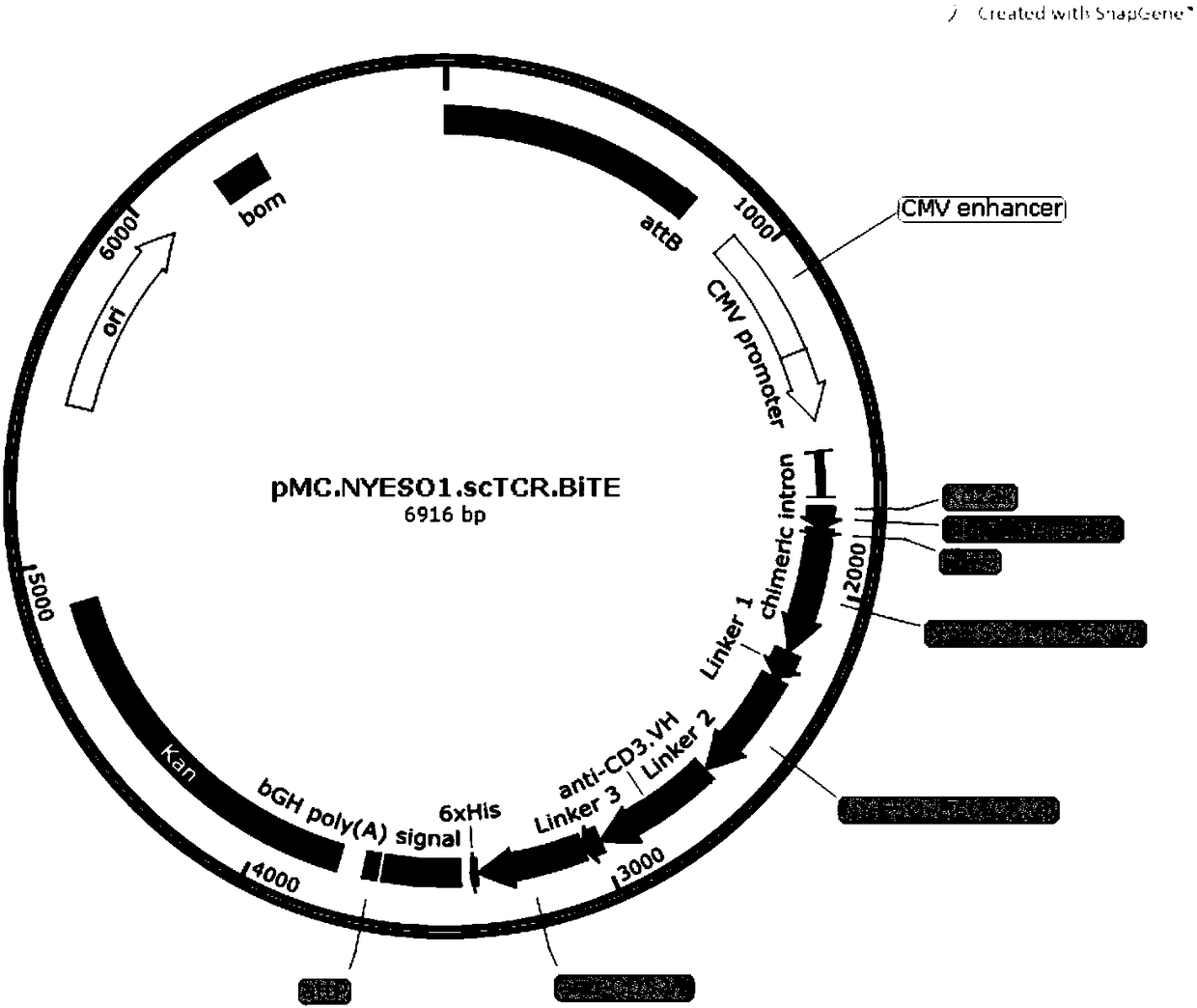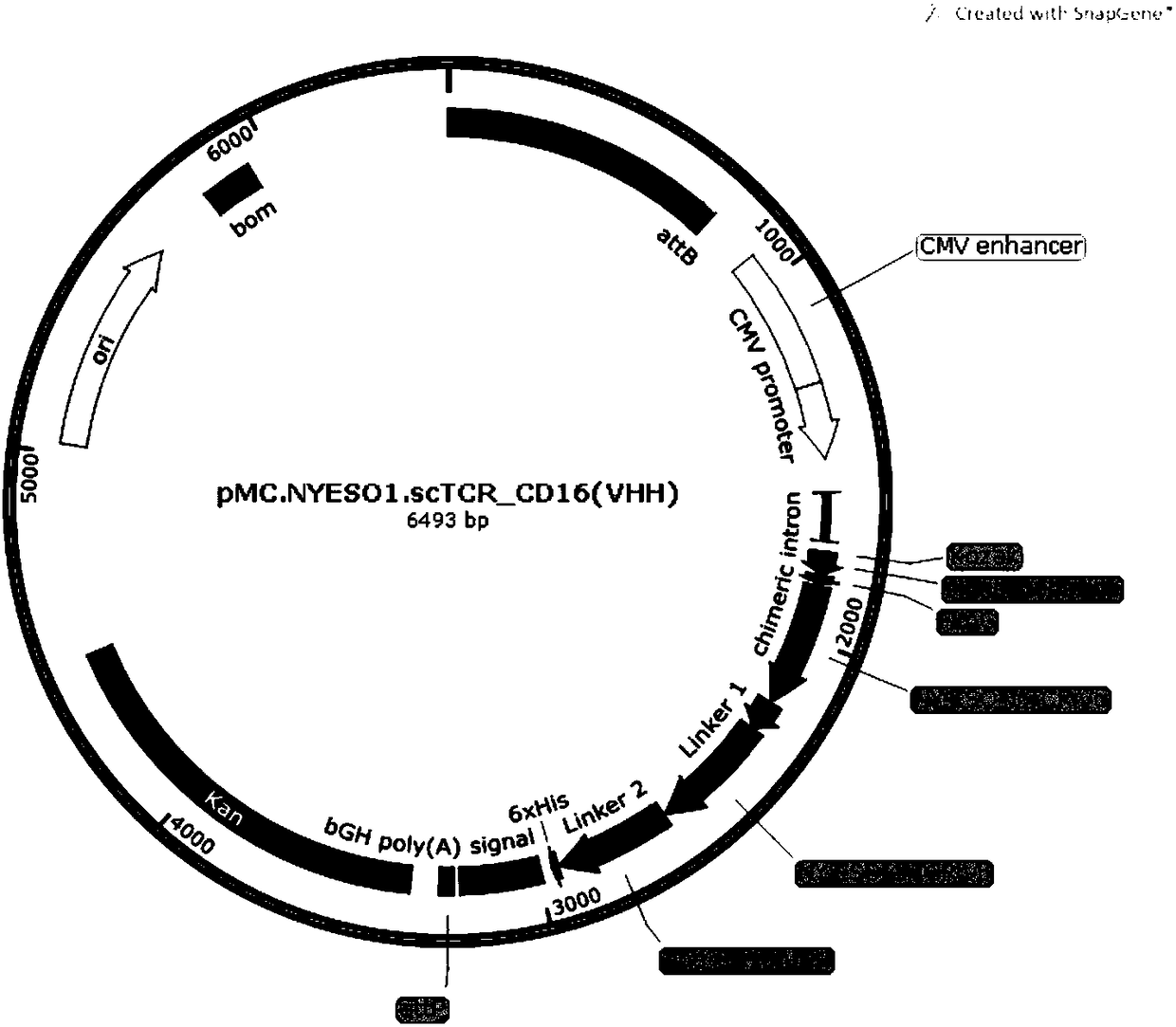Minicircle DNA carrier expressing target cell-effector cell bridge, preparation method and application thereof
A technology of effector cells and target cells, applied in the direction of intact cells/viruses/DNA/RNA components, receptors/cell surface antigens/cell surface determinants, recombinant DNA technology, etc.
- Summary
- Abstract
- Description
- Claims
- Application Information
AI Technical Summary
Problems solved by technology
Method used
Image
Examples
Embodiment 1
[0055] Example 1, Construction of target cell-effector cell bridge (BTEC) bridging CD20 and CD3 (single domain antibody format)
[0056] (a) Construction of a target cell-effector cell bridge (BTEC) comprising a single-domain antibody specifically binding to CD20 (V H H), and a single domain antibody specifically binding to CD3 (V H H); CD20 is the target point on the target cells, and CD3 is the target point on the effector cells.
[0057] (b) CD20-binding single domain antibody (V H The amino acid sequence of H) is shown in SEQ ID NO: 1; the single domain antibody (V H The amino acid sequence of H) is shown in SEQ ID NO:9.
[0058] (c) Constructing a minicircle DNA vector expressing BTEC, comprising the CD20-binding single domain antibody (V H H) the coding gene, and the CD3-binding single domain antibody (V H H) coding gene; and suitable expression elements are also included in the minicircle DNA vector.
[0059] (d) An expression cassette comprising BTEC in the minic...
Embodiment 2
[0063] Example 2, Construction of target cell-effector cell bridge (BTEC) bridging CD20 and CD3 (single-chain antibody form)
[0064] (a) Construction of a target cell-effector cell bridge (BTEC), including a single-chain antibody (scFv) specifically binding to CD20, and a single-chain antibody (scFv) specifically binding to CD3; CD20 is the target on the target cell , CD3 is the target on effector cells.
[0065] (b) A CD20-binding single-chain antibody (scFv), comprising: a light chain variable region with an amino acid sequence as shown in SEQ ID NO:3, and a heavy chain variable region with an amino acid sequence as shown in SEQ ID NO:4 A CD3-binding single-chain antibody (scFv), comprising: a light chain variable region with the amino acid sequence shown in SEQ ID NO:12, and a heavy chain variable region with the amino acid sequence shown in SEQ ID NO:13.
[0066] (c) constructing a minicircle DNA carrier expressing BTEC, comprising the coding gene of the single-chain ant...
Embodiment 3
[0076] Embodiment 3, the construction of the microcircle DNA vector expressing BTEC
[0077] According to the construction ideas and methods of Examples 1 and 2, microcircle DNA vectors expressing several BTECs were constructed.
[0078] (a) Construction of BTEC, comprising single-chain T cell receptor (scTCR) binding to NY-ESO-1, and single-chain antibody (scFv) binding to CD3; the resulting minicircle DNA vector NY-ESO-1.scTCR / CD3( The structural diagram of scFv) is shown in figure 1 shown.
[0079] (b) Construction of BTEC, comprising a single-chain T cell receptor (scTCR) that binds NY-ESO-1, and a CD3-binding single-domain antibody (V H H); The resulting minicircle DNA carrier NY-ESO-1.scTCR / CD3 (V H The structure diagram of H) is as follows figure 2 shown.
[0080] (c) Construction of BTEC, comprising a single-chain T cell receptor (scTCR) that binds NY-ESO-1, and a CD16-binding single-domain antibody (V H H); The resulting minicircle DNA vector NY-ESO-1.scTCR / CD1...
PUM
 Login to View More
Login to View More Abstract
Description
Claims
Application Information
 Login to View More
Login to View More - R&D
- Intellectual Property
- Life Sciences
- Materials
- Tech Scout
- Unparalleled Data Quality
- Higher Quality Content
- 60% Fewer Hallucinations
Browse by: Latest US Patents, China's latest patents, Technical Efficacy Thesaurus, Application Domain, Technology Topic, Popular Technical Reports.
© 2025 PatSnap. All rights reserved.Legal|Privacy policy|Modern Slavery Act Transparency Statement|Sitemap|About US| Contact US: help@patsnap.com



